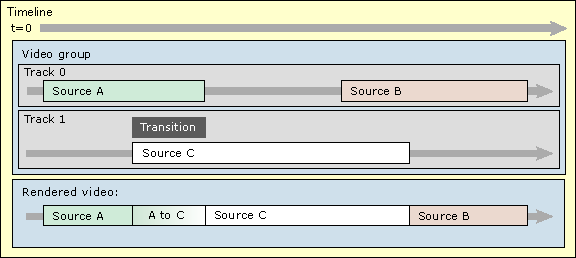
| Microsoft DirectX 8.1 (C++) |
A transition is a way to segue from one video track to another, using a visual effect such as a fade or a wipe. In the preceding example, the video cuts are instantaneous. Now consider the same video group with a transition added to it:

The transition resides on Track 1. It represents a transition between that track and the layer above it (Track 0). At the start of the transition, the rendered output is entirely from Track 0 (source A). At the end, the output is entirely from Track 1 (source C). In between, the output transforms from Source A to Source C. In a fade transition, for example, one source progressively fades into another.
The rendered output is schematized along the bottom of the illustration. In the transition region, the video image transforms from Source A to Source C. There is still a jump cut from Source C to Source B, because the track does not contain a transition at that point.
Note that a transition has a particular direction. At the beginning of the transition, the video output is mostly from Source A. In the middle of the transition, the video is a mixture of the two sources. At the end, the output is mostly from Source B. By default, a transition goes from the track with lower priority to the one with higher priority, as shown. However, you can specify the opposite behavior. The following illustration shows an example of this situation. Track 0 fades to Track 1, and then Track 1 fades back to Track 0. Both transitions reside on Track 1.
